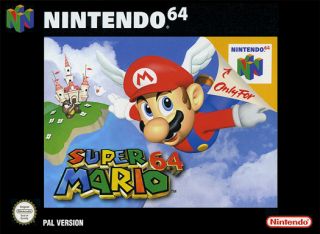
Welcome to the third part of this exhaustive look at N64 launch game Super Mario 64. We've barreled through the first of Bowser's traps and recovered the key to the castle's basement. What should we expect to find down here? Treasure? Mysteries? The decomposed remains of the Mushroom Kingdom's many political prisoners? Well, the answer might surprise you. Or it might not, given that this game's been out for almost twenty years (yeah, I feel old too). There's actually a total of four new courses and six secret Stars, some of which are spread across two secret areas and the next Bowser Road. I'll be splitting this up evenly into two entries, because that last one kinda got a little out of hand - fortunately, we have exactly ten courses left to explore, so that divides itself rather nicely into five more updates including this one.
Anyway, enough inside baseball. We've got a poisonous maze and a whole lotta lava to make our way through.
MIPS
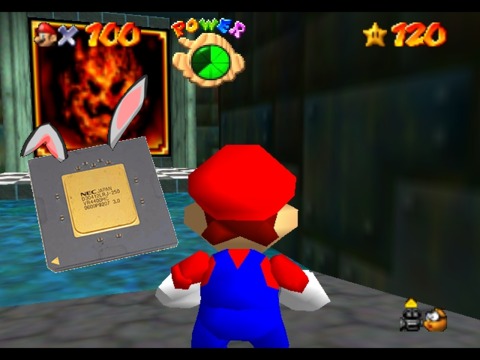
The first thing that actually greets us down in the basement area is a hoppy yellow rabbit named MIPS. These rabbits are something of a recurring menace in future Mario games, most recently reappearing in Super Mario 3D World, due to their cunning and the way they tend to exhibit my physical awkwardness. I mean, uh, the players' physical awkwardness. While very quick and prone to taking sudden random turns away from the player, it's possible to predict its movement after a time, especially if it gets caught in a number of dead-ends around this area. You might think with an all-caps name like MIPS that it has some sort of cute acronym moniker, and you'd be right: His full name is Microprocessor without Interlocked Pipeline Stages. Rolls right off the tongue, don't it? Apparently, he was created back when the Nintendo 64's hardware was being tested (it's the name of the processor that the N64 uses) and was added to Super Mario 64 because the R&D programmers liked the little guy. See what I mean about the developers just tossing everything they had into the stew pot? The little guy appears once when you have 15 Stars, and again when you have 50, with a secret Star each time he's successfully caught.
Toad
There's a Toad in the Hazy Maze Cave course room, and talking to him will grant Mario a bonus Star. It's the first of three Toads that actually help you like this, though this one is around the fourth or fifth Toad you might actually encounter. I can imagine players just ignoring the little guys at this point, feeling as they do that they have a much better grasp on the game's mechanics and no longer need their hints. There's such a thing as being too smart for your own good, turns out.
Hazy Maze Cave
The Course
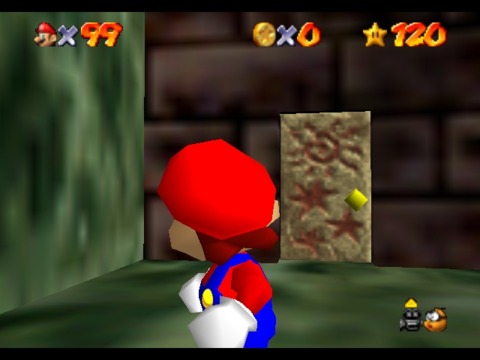
The Hazy Maze Cave portrait room doesn't so much feature a portrait than a big inky pool you're meant to jump into. This pool has the same texture as Metal Mario, and the Metal Cap secret zone just so happens to be linked to this course though it's anyone's guess whether that was meant to be a hint or not. It's also an opportunity for the graphic designers to show off some more of the N64's ripply textures; something that is subtly featured whenever Mario jumps through a portrait but is far more pronounced and persistent here. If one were the pedantic type, they might consider what purpose this room has in the castle. A big hole surrounded by walkways and a black and white tiled floor. I'm thinking "underground communal bathroom for Toad servants". Princess Peach is a goddamn tyrant, I swear.
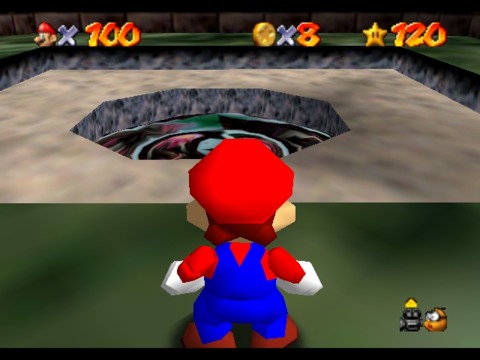
The course itself is another hodgepodge of random ideas for puzzle conceits, linked with a tenuous theme of being subterranean in nature. They might well have called it Mixed Bag Cave, except that would've presented game reviewers with a tricky problem when it came time to describing it. The titular hazy maze is, indeed, a maze of twists, turns and secret exits, but you could easily extend that descriptor to the entire course. It's essentially a bunch of linked rooms each with a different central theme; one has a rolling rock obstacle and a big "black hole" at the center, while another is an aquatic area with a large dinosaur living it (Dorrie, making his first Mario appearance). We'll go through these areas as we talk about the Stars, but suffice it to say the maze-like elements of this course don't begin and end in the poop gas labyrinth.
Neat touches? Well, there's the "you are here" maps that proliferate Hazy Maze Cave, as if the enigmatic red and blue markings have any evident purpose. Presumably placed there by the developers (yeah, I know, they were literally placed there by the developers, but I'm talking about whether some in-world entity built them or if we're supposed to simply acknowledge them as a convenience crafted for the player's sake. I don't really like to ponder "acts of God" in a Mario game) to guide wayward players, it actually explains and describes very little, providing instead a rough quartet of linked, misshapen boxes than anything resembling a landmark. There's also the matter that the stage is on several tiers, which can't accurately be represented by a 2D map. Well, they tried at least, and considering that there's one right at the beginning of the course, it wouldn't do to give too much away about what the course has to offer.
I'd like to mention the music too. It's a remix of the classic underground theme from Super Mario Bros. but with something of a salsa feel to it. The theme changes once you get to Dorrie's underground lake, becoming more ethereal in the way the underwater courses tend to sound. I really lack the words to properly describe the music in this game, but I have a lot of appreciation for how it varies depending on the circumstances. It's rare an OST gets this complex (though I hear the actual OST unfortunately emits a lot of these variable details).
The Stars
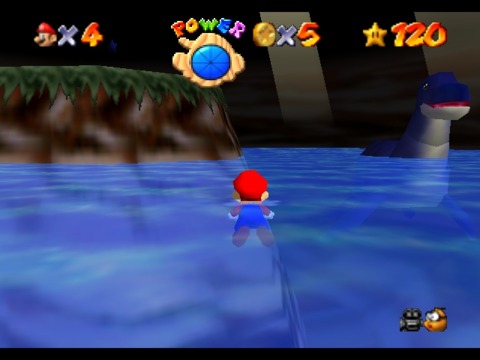
The first Star involves taking a trip to see Dorrie, the game's passive plesiosaur (a word which the spell-check wants me to change to "applesauce"). Dorrie's an interesting creation for a number of reasons, the first being the sheer size of the thing. It moves very slowly and doesn't animate too much, presumably to get around the issues of animating such a large creature with the N64's processing power. Something I've not spoken about too much is Mario's uncanny knack for walking up sheer slopes as long as the friction isn't set too low, and so a player who didn't read the nearby sign explaining that a ground-pound will cause Dorrie to lower his head to let Mario steer him around will instead find that they can simply run up Dorrie's neck despite it being a 80 degree sharp incline. Once on Dorrie's head, Dorrie then endeavors to head towards wherever Mario is looking. He only has so much wriggle room in this regard because of the relative size of himself and the underwater loch he calls a home, so it'll often mean taking a circuitous route around the central island to get to the desired location. Fortunately, for this Star in particular, the desired location is that central island, which can be reached from any part of the lake.
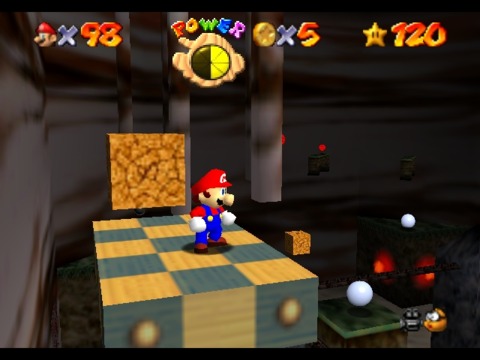
The eight red coin challenge makes an early appearance as the second Star, requiring that Mario navigate a single room to find all eight. This room is the largest in the course, however, comprising of three distinct "floors" (though there's very little actual floor to be seen) filled with moving platform puzzles. The four-directional pad that the player must use to navigate the middle of these three floors is a 3D interpretation of a similar puzzle back in Super Mario World, where Mario had to jump to change the direction of the platform he was using so that it could be weaved through obstacles and dangers. The top floor's a far more straightforward fixed path around the room, using the same yellow-and-blue checkered elevator that we saw back in Bob-Omb Battlefield. I've always wondered if the yellow dots on the front were meant to be eyes (is it alive?) or headlights (not that they illuminate anything). Maybe they're couplers and there was supposed to be a longer chain of these things? I'm not sure.
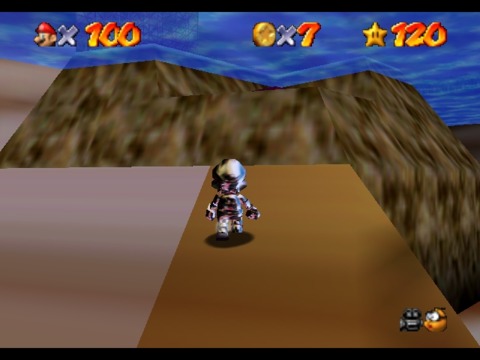
The third is another cap-specific Star, though if you consider that this particular cap can be found in the same course it's not exactly an inconvenience. It once again depends on Metal Mario's ability to walk across the bottom of any body of water because there's an underwater switch that needs pressing. The Star hint, "Metal-Head Mario can move!" is a bit of a cheeky misnomer, as Metal Mario's pace slows to a crawl whenever he goes underwater (not to mention that it's not just his head that turns metal), but the player will need to book it in order to reach the switch in time. It's curious that despite being awesomely strong and durable while metal, there aren't any Stars that take advantage of this; they all choose instead to focus on Mario's increased density. I know that feeling. Man, highschool was rough.
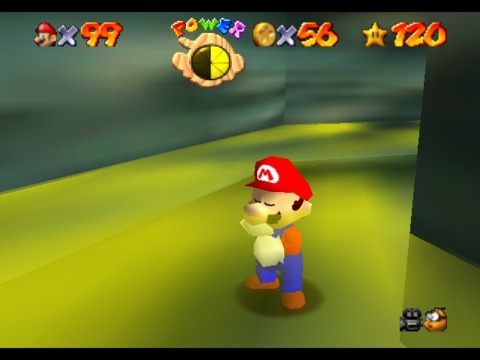
Four and five are odd because they both involve exiting the poop gas maze that gives Hazy Maze Cave its name. However, both of these exits are inconspicuous doors that are a little higher than the maze itself, so a player is likely to miss them if they're simply focusing on what's at eye-level height. Due to the confined corridors of the maze the camera gets in real close, making the eye-level camera thing more of an issue. In both cases, the player simply enters a door and follows a brief path to a waiting Star, so we have one of the first cases of a course simply repeating the same puzzle-solution. As there's little that's given away with the two hints ("Navigating the toxic maze" and "A-maze-ing emergency exit") it's entirely possible the player will find these two in the opposite intended order. The emergency exit Star is at least notable for an American Gladiators-style sequence where Mario has to climb across a cage ceiling, holding the attack button throughout in order to stay grasped on. This sort of set-piece will be far more common in the courses to come.
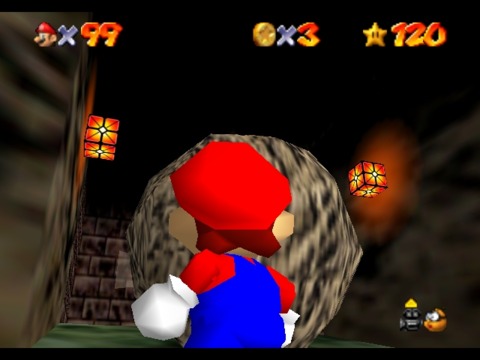
With six, we once again have our "player might luck upon this ahead of time" Star, situated in a small nook above and after the rolling rocks of the "black hole" area. It requires some wall-jumps to reach, but the hint doesn't suggest anything besides it being beyond the rolling rocks. This room is unusually terrifying, by the way: a central abyss with an angled floor that can slide you down there if Mario happens lands the wrong way. It's also a hub to every other area, so the player might find themselves passing through it regularly despite the danger.
100-Coin Challenge: Hazy Maze Cave is one of the worst courses for this challenge, because most of the coins are spread out across the many parts of the course and that means giving it every opportunity to kill you. The hazy maze itself, for instance, has a blue coin block that provides a secondary purpose in pointing the way to the one of the secret exits, but it's hard to actually figure out where the line of coins are going in the handful of seconds it gives you. These blue coins are all necessary too, as the full course barely gets over 110 coins and that accounts for the bats and spiders who all seem to hang around bottomless pits that are happy to gobble up loose coins that fly their way. There's also a couple of eyes from Big Boo's Haunt around the elevator section and they're almost impossible to get around, being suspended as they are on narrow pillars.
Cavern of the Metal Cap
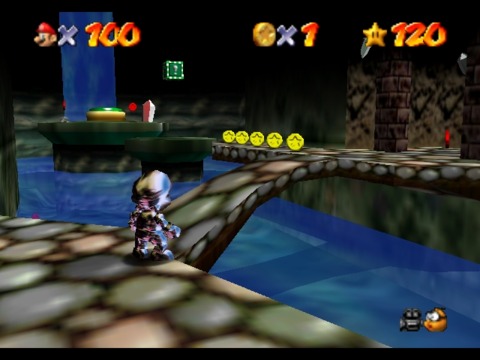
Unconventionally, this secret course can only be found in Hazy Maze Cave; in every other case, the secret areas/Stars are accessed in the castle proper. This requires that the player use Dorrie to reach a far door in the underground lake area, passing through a tunnel and into another inky pool to reach a separate part of the world. The tunnel has the green switch at the end, and adroitly demonstrates Metal Mario's secondary (or perhaps primary, given its prevalence in finding Stars) ability of walking along the bottom of bodies of water. There's a red coin secret Star here too, naturally, and most of them are found in the water. The water, I should point out, will quickly carry a non-Metal Mario through its exit and down the waterfall outside of Peach's Castle. It's a heck of a walk back, too.
Lethal Lava Land
The Course
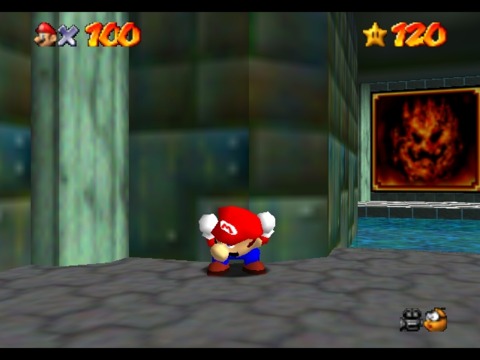
The only actual portrait in the basement area is an ominous land of volcanoes, lava and fireballs. Despite its fearsome look, Lethal Lava Land is actually fairly humane in as far as giving players second chances. Hitting the lava that covers around two-thirds of the surface of the level only damages Mario a little bit, tossing him high enough in the air to let players navigate him back onto safe land before he falls again. There are times when he can't easily be navigated back, taking repeated third-degree burns to his charred arse (or his "charse", as medical professionals would say), but these are fairly rare situations and only tend to occur where Mario would've otherwise fallen down a bottomless pit otherwise, such as the platforming sequences inside the volcano.
Speaking of which, this level is one of a handful to be split up into discrete areas. The "surface" is simply one rather flat interconnected maze of different flame-related puzzles surrounded by a sea of lava and a few outcroppings with coins that Mario can either leap to or use a shell/Flying Cap to reach. The shells, which I haven't really spoken about yet, are a great yet absurdly touchy means of getting around courses quickly, especially those that are fairly level topographically. The shell instantly vanishes if Mario hits any kind of wall, regardless of height, which often leads to problems more troublesome than the shell might be worth.
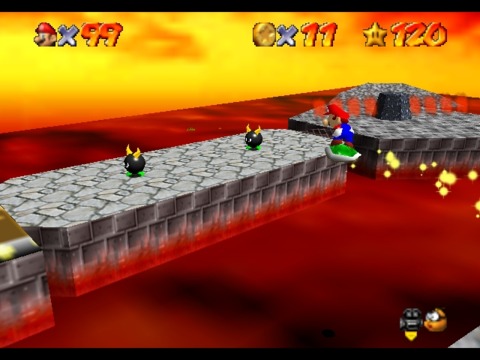
It takes a daring soul to even attempt to enter the volcano before the hint suggests trying so, but we find that the inside is considerably larger than the outside. It's possible the rest of the volcano was just deep underground too, of course. This area simply splits into two paths to two separate Stars, but it's notable because players might not consider how it factors into the 100-Coin Challenge. The aforementioned shell won't appear until the player as selected one of the hints for the two Stars in the volcano, mostly because the challenge of those first four Stars also includes navigating to their relevant places on the map instead of taking a shortcut over the lava.
I'm not sure when games on Nintendo platforms and elsewhere started playing Indian Carnatic music--often heavy on bass-y rhythm--in stages with lava, volcanoes or an otherwise extremely hot environment but it's been a recurring musical theme to many volcano stages created after Lethal Lava Land. The volcano course Hot Top Volcano in Diddy Kong Racing, for instance. Maybe it's just a curry joke: a foodstuff as beloved in Japan as it is in the UK and the Indian subcontinent.
The Stars
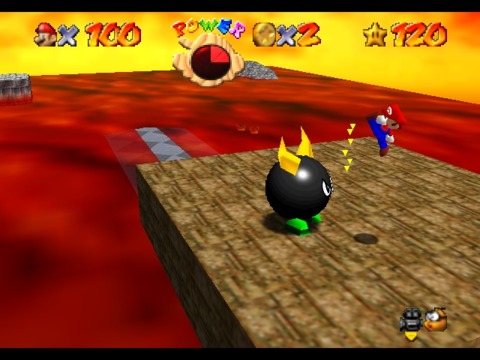
The surface area of this course is so weird. There's very few thematic connections between its various sections, despite the ever-present threat of molten rock. The bullies are one of the few instances where the game really drives home the menace of the lava sea, as Mario must fight tooth and nail to prevent being shoved off the edge of the platform: a fate that wouldn't mean a thing in many other courses. The big bully is situated as far from the start as possible, requiring that Mario explore quite a bit of this area to reach him. In fact, depending on the route they take, they'll almost certainly pass through one of the areas for the second two Stars. Bully fights essentially amount to timing, like a great many other fights. You can attempt to hammer the punch button, but the chances are that the wily bully will run right through a gap and stun Mario enough to keep pushing him back into lava. It's a very risky strategy that an impatient player will quickly learn isn't tenable. Instead, the trick is to find the rhythm, hitting it at the moment it gets close and then continue to press the advantage in the same way they would press the advantage against a stunned Mario. In other words, Super Mario 64 is the original Dark Souls.
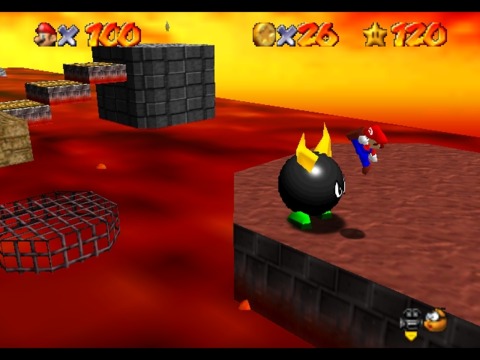
The second Star is very much the same as the first, just with more minions to slay along the way. With its rather vague hint of "bully the bullies", the player might believe they have to remove the many bullies strewn across the surface area, but really they just need to focus on the three at the far back right platform. Defeating this trio summons another big bully out of nowhere, and another, slightly easier sumo fight, ensues. It's a little unfortunate that they had to hammer home this aspect of the course with a repeated boss fight, but then it is the one occasion where "combat" in this game becomes more complex than simply jumping on a goomba, grabbing Bowser's tail or sucker-punching a Boo when his back is turned.
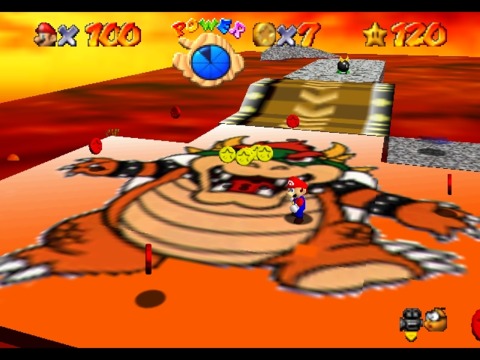
The third Star feels like a joke on sliding block puzzles, which even at the time were sort of omnipresent and widely reviled. The sliding block puzzle is of Bowser himself, and will complete (and re-scramble) itself on its own. All the player has to do is avoid the quickly moving panels and grab eight red coins in close proximity. It's a shockingly easy take on the red coin puzzle, requiring very little moving around, though I wonder how long the developers wrestled with the idea of a 3D sliding block puzzle that eventually became this much reduced interpretation of the concept. Makes me wonder if there wasn't going to be some crazy 3D Tower of Hanoi puzzle elsewhere. (I like the small detail where, once the puzzle is complete, the 2D Bowser image spits out a handful of coins. It must use a proximity sensor, because this puzzle could potentially complete itself numerous times before Mario ever reaches it. Then again, I'm sure it won't start animating until he's nearby and within the limited draw distance for 2D animated objects.)
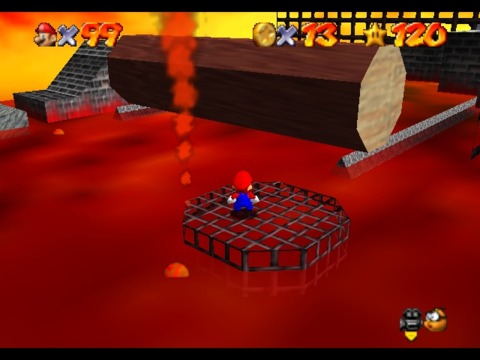
Fourth Star requires a rolling log instance, possibly my favorite of the 3D obstacles the developers conceived for Mario, if only conceptually. It's entirely based on physics, rare for such an early 3D game, and while there's plenty of cases of pivoting seesaws and the like the rolling logs are a little more involved. In order to get the log rolling, the player has to stand on one side of the cylinder, forcing it to go down and rotate the log in that direction. As it goes down, it drags Mario along with it, so the player has to keep a steady pace in the opposite direction to maintain the same speed as the turning log, making sure not to drop in speed, which will subsequently drop their ass in the lava, or go too fast, which will reverse the direction of the log and undo their progress. In fairness, and like many other obstacles of this sort, there was precedent in earlier 2D Mario games - I'm sure Yoshi's Island had a few rolling logs like this. It's still a neat puzzle that requires more precision than timing, especially when trying to find the "sweet spot" with the control stick.
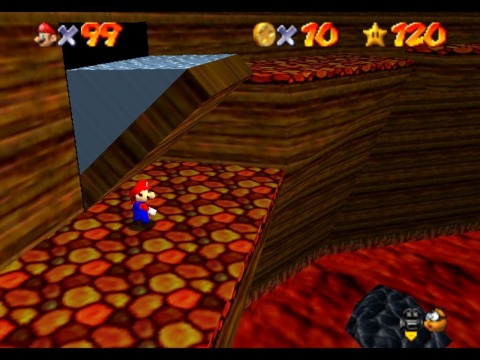
With the next two Stars we enter the volcano and start heading up one of two separate paths. There's no clear indication from the first hint which route is the right one for which Star, but it doesn't really matter. The game tosses the player a bone here, allowing them to restart from the volcano if they should happen to fall. It's not a big help if they're trying for the 100-Coin Challenge: in order to return to the surface, they either have to manually exit the level and run back to the portrait, reset the game or grab one of the two Stars down here. One route involves a row of obstacles on solid ground, while the other involves floating up to a few mid-air traps on an elevator. It's possible to reach one Star from the other when sufficiently high up, but it's not an easy jump and the resulting fall into lava won't be pretty.
100-Coin Challenge: It's not a particularly easy coin challenge with the amount of danger all around, but sweeping the level with the shell and then returning for all the coins on platforms will net a considerable number right away. If the player then enters the volcano they should find enough via the "hot-footing" route to put them over. The difficult part will be that shell sweep across the various lines of coins sitting on various rock outcroppings, so it's vital to do that part first. This course also has a Crazed Crate that, players will learn, require a plan in place before the player should pick it up. It'll jump Mario several times before a final destructive landing, leading to a useful five coins. In this case, the player needs to steer it to the "bully the bullies" platform to get the most out of it, otherwise it's more than likely to end its frantic hopping in the middle of a pool of lava: meaning zero coins and a flame-grilled Mario. The 100-Coin Challenges are usually full of considerations like these, making them a bit more substantial than a simple scavenger hunt (which isn't to say I don't enjoy those, Rare fans).
Vanish Cap Under the Moat
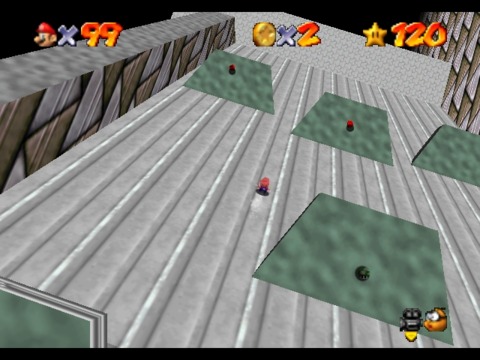
You could theoretically find this secret Star at any point after entering the basement, but I wanted to spread these out between the two courses. There's a door in the basement area that takes you to a flooded chamber that turns out to be the moat control. However, it is not a re-moat control, as once the moat has been drained it cannot be refilled again (at least as far as I'm aware). What it does open are two useful exits: one is on the side of the castle and links the moat control room to the castle exterior, making it slightly faster for people reloading the game to get to the basement, and the Vanish Cap zone which is a hole upon which the moat once sat. Unlike the first two cap areas, there's no sort of logical explanation for what this area is, and it simply involves a slanted drop followed by a bunch of elevators to the blue switch tjat activates every Vanish Cap block in the game. The Vanish Cap's primary function is to move through certain types of barriers, usually signified by being of a mesh or transparent nature. Its secondary purpose makes Mario immune and invisible to enemies, though it also means he cannot defeat them either (except you totally can, which doesn't seem fair). Besides the red coins on the initial slide, which are very missable unless the player knows where they are, this isn't a particularly rough course. If Mario falls off, he ends up a few feet away from the secret area's entrance no worse for the wear (as in, you don't lose lives in these secret areas) so either way it's not terribly frustrating. Of course, one might wonder why they have lives at all if the game doesn't really do checkpoints and no saved progress is ever lost... I believe beyond Super Mario 64 they simply become a vestigial figurehead of the Mario franchise. Get it, figurehead? Because the lives counter is Mario's hea- you know, we're probably done here for today.
Thanks for reading even more of my Mario musings, and while I'm not sorry to leave Hazy Maze Cave or Lethal Lava Land behind the next two courses are even more disliked by the general Super Mario 64 community. Much like Final Fantasy VI's unhinged villain Kefka: if there's two things I can't stand it's sand and submariners...
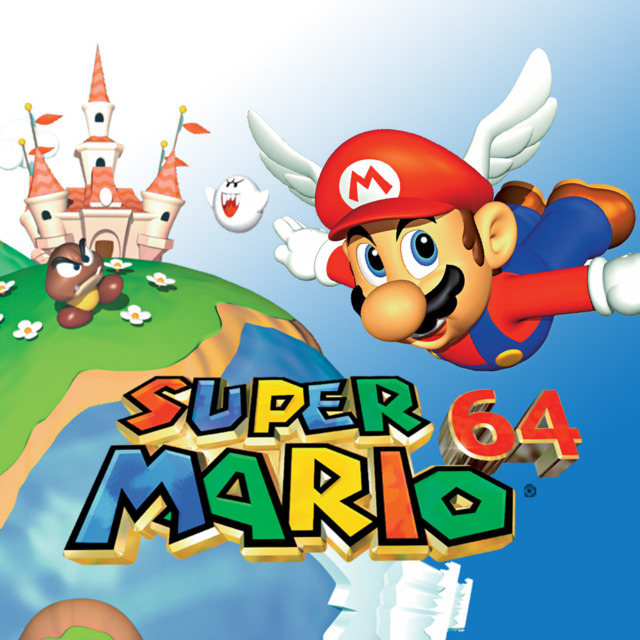
Log in to comment